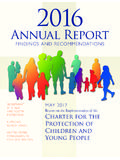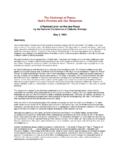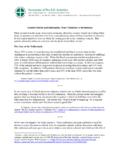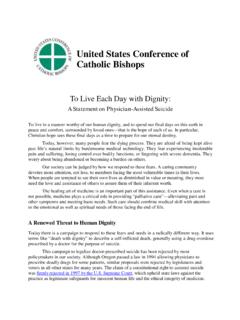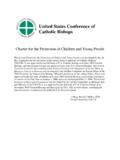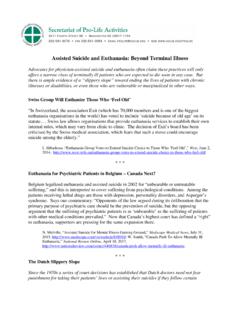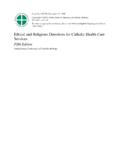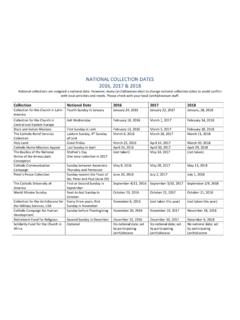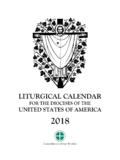Transcription of Maximizing Medication Safety - usccb.org
1 1 Maximizing Medication Safety By Sister Barbara Battista, SP Medications help us stay well, or in some cases to return to a state of well-ness. Most of the time this is true, but what about when things don t quite work out that way? As good as medications can be, they can also end up being the culprit in all kinds of medical misadventures. Prescribing, dis-pensing, and taking medications has become a complicated process. That complexity increases as we age. The older adult, when compared to chil-dren and young adults, is much more likely to experience adverse events directly related to Medication use. Thankfully, we do have guides to help us avoid most of the potential hazards along the way.
2 This article will explore how to safely and effectively utilize medications to optimize our physical, emotional, and mental well-being. Major topics we will explore include developing a proactive approach to communicating with your healthcare provider; interventions to lessen your risk of falling; non-pharmacologic alternatives to medications; and particular systems that de-crease the risk of adverse health outcomes related to taking medications. My goal is to expand your understanding of how safe and appropriate use of medications can improve your quality of life. Along the way I hope to re-kindle within you a sense of gratitude for the gift of good health and a re-newed commitment to honoring your body by adopting or continuing behav-iors that truly support human thriving.
3 Spring 2018 Volume 13 No. 1 In This Issue Resources 7 Editor s Note 7 Calendar 7 Sister Barbara Battista, SP, , PA-C, is a Sister of Providence of St. Mary-of-the-Woods, Indiana. As a pharmacy supervisor at Cook Coun-ty Hospital s Outpatient Pharmacy, she saw how poor communication and unsafe Medication prac-tices affect health outcomes. Sr. Barbara went on to become certified as a physician assistant and has served in several medical practices in West Virginia, Illinois, and Indiana. Currently she minis-ters as a physician assistant in Occupational Medi-cine in Indiana. She serves on numerous boards and has presented a webinar for NRRO. It will be increasingly important to understand that the use of medications in the older adult population should be directed toward support of the whole patient.
4 Thomas R. Clark The Role of Medications in the Lives of Older Adults: An Overview 2 Aging and Well-being Well-being is a rich concept worthy of a much more thorough discussion than this short article allows. For our purposes, I am primarily con-cerned with the domain of physical health as one component of well-being. I suggest we use the following definition from the Center for Dis-ease Control and Prevention (CDC) section on health-related quality of life: Health is more than the absence of disease; it is a resource that allows people to realize their aspirations, satisfy their needs and to cope with the environ-ment in order to live a long, productive, and fruitful life.
5 Speaking of definitions, what do we mean when we say older adult? There is no consensus on what exact age constitutes older adulthood. When I use older adult in this article I am refer-ring to those persons 65 and older. Let s look at what might get in the way of coping with our environment or living a long and pro-ductive life. One obvious, though not necessari-ly warmly embraced fact, is that aging changes us. The evidence is all around us: our skin is dryer; joints are not as flexible; we lose strength in our hands; and it is harder to see at night. We all share internal, physiologic changes. The outward signs of these changes vary from per-son to person. We may not look our age yet the way our body responds to medications is a func-tion of our age.
6 Some of these internal changes include the fact that our total body water content decreases. Our muscle mass also declines as we age. Less muscle mass means a weaker grip, more effort to get up out of a chair, or more difficulty climbing the stairs. Additionally, blood flow de-creases. As we age we accumulate more total body fat in relation to muscle mass. The resistance in our vascular system increases. These physiologic changes have direct effects on how our body responds to various stimuli, including medications, dietary changes, and our external environment. Yes, there is a reason why we need more lighting to see clearly, more time to climb the stairs, and at times, a little help to get our GI tract moving along.
7 Just as we know we are not as agile or flexible as we were at age sixteen, the same is true for our physiolo-gy. The mechanisms mentioned above have effects at the cellular level where medications act and food is absorbed. The net effect of these changes results in many older adults needing a lower dose and perhaps fewer doses per day of some very common medications such as those used for high blood pressure, heart rhythm disturbances, and diabe-tes. Because of this increased sensitivity, one way to enhance well-being as we age is to focus on risk reduction in terms of the use of medica-tions. The remainder of this article will address specific interventions to accomplish this goal of reducing the risk to our health and enhancing our well-being.
8 Communication is the Key Medical visits look and feel so different today as compared to twenty or thirty years ago. By the time we actually see our medical provider, doctor, physician assistant, or nurse practitioner, we may have interacted with two or three per-sons. Often, we are faced with answering a bar-rage of questions with precious little time allot-ted for us to pose questions of our own. Making the time to pose our questions is a vital part of every medical encounter. I suggest that you consider adopting a proactive approach to com-municating with your provider. Preparing for each visit can go a long way in helping you avoid some common Medication related issues.
9 Keeping a journal or log of these visits can also Maximizing Medication Safety , continued Engaging Aging Spring 2018 3 Engaging Aging Spring 2018 prove quite helpful. Write down your symptoms or concerns Medical providers are trained to consider any new symp-tom or complaint as a side effect of a medica-tion until proven otherwise.
10 This is why it is so important to let your provider know if you have any new problems or complaints. It is tempting to decide that such things as dry eyes, or getting a little lightheaded at times just comes with get-ting older. That is not necessarily true. By rais-ing these types of issues, you may be helping your provider uncover some Medication issues that can be easily corrected by decreasing a dose or changing to a different Medication . Update your Medication list This includes all eye drops, topicals, over-the-counter (OTC) meds, and herbal supplements. They are all important when considering drug-drug and drug-food interactions. Also, you should check to see which meds need refills and communicate that to the provider during the visit.
